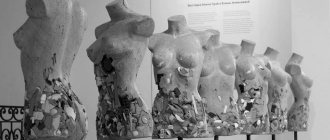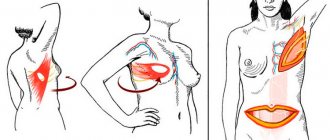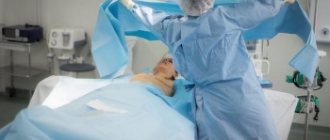Consultation with plastic surgeons with over 20 years of experience – free! Sign up by phone. Waiting for you! Re-endoprosthetics or re-mammoplasty is an operation to replace breast implants. Breast implant replacement can occur for a variety of reasons, but the most common is fibrous capsular contracture (constrictive fibrosis). In the first months after breast augmentation with implants, a capsule of connective tissue is formed around the endoprosthesis, the density and thickness of which depends on the individual characteristics of the body’s reaction to a foreign body and the quality of the implant.
Around modern textured implants of the fourth and fifth generations, a barely noticeable capsule is formed, more like a “web”, which cannot be said about the smooth implants of the first generations. A dense, hard capsule around a smooth implant often leads to fibrous capsular contracture, compresses the endoprosthesis and causes deformation of the mammary glands.
Capsular contracture – a capsule of dense fibrous tissue compressing the implant
Indications
In addition to aesthetic reasons and complications, re-endoprosthetics may also be necessary in cases where an implant was previously installed that requires replacement after a few years.
Removal of implants due to complications includes the following:
- capsular contracture (formation of scar tissue around the implant);
- asymmetry of the mammary glands;
- displacement of the endoprosthesis;
- violation of the integrity of the implant;
- inflammation;
- contouring or wrinkling of the implant;
- loss of sensation;
- accumulation of fluid in the chest;
- ptosis (drooping) of the breast.
Restoration of female breasts after mastectomy
How to choose the right implant? How does the operation take place? Will an implant cause a recurrence of cancer?
According to the “gold standard”, the main type of reconstruction today is the so-called two-stage reconstruction. Its essence is that an expander-expander is installed simultaneously with the removal of the breast or delayed in the first stage. It allows you to achieve the optimal volume of tissue for the subsequent installation of an implant corresponding to the desired shape and volume of the breast. The expander gradually stretches the tissue by pumping sterile saline into it.
During the second stage of reconstruction, the temporary expander is replaced with a permanent silicone implant and, if necessary, the healthy breast is corrected. The algorithm for selecting an implant after a mastectomy is somewhat different from the selection for standard aesthetic breast surgery. It is necessary to take into account the difference in projection between a healthy breast and one that needs restoration. The thickness and condition of the skin are taken into account, as well as what will be covered with the implant, and whether additional coverage is required, for example, with a mesh or an ADM biological flap. The main goal of the oncological surgeon during the second stage is to obtain optimal symmetry.
Silicone is an inert material that does not increase the incidence of breast cancer and does not increase the risk of recurrence. This fact has been proven in many authoritative studies.
How is the mammary gland restored by the patient’s body tissues? Where do tissue flaps (skin, muscle, subcutaneous tissue) come from? How well do they take root?
Reconstruction using the patient’s own tissue is a separate and rather complex area of reconstructive surgery. The most common donor area for transplantation is the abdomen. The tissue can be transplanted into the chest area with or without the rectus abdominis muscle. Slightly less often, tissue from the back or buttocks is used. To achieve additional symmetry, sometimes after reconstruction with implants or after transplantation of a flap, lipofilling is additionally used - transplantation of one's own fat, which fills all the smallest irregularities after reconstruction.
Breasts reconstructed in this way feel tactilely a little more like their own tissue than those reconstructed with an implant.
If you still have questions, you can ask them to the oncologist-surgeon online in the Doctis application.
Contraindications
The list of contraindications for surgery to remove implants includes the same reasons as any other operation:
- problems with blood clotting;
- presence of chronic diseases;
- systemic organ damage;
- diabetes;
- internal inflammation;
- oncological diseases;
- pregnancy and lactation period.
Other contraindications may be identified during examination of the patient and based on test results.
Rehabilitation after breast implant replacement
During the rehabilitation period for repeated breast correction (mammoplasty with endoprostheses or removal of implants with a one-stage breast lift), wearing compression garments for 1.5 months, regular dressing visits and compliance with all instructions of the plastic surgeon are required. For 2-3 months after the operation, it is necessary to refrain from increased physical activity and sports, avoid stress on the upper shoulder girdle, and do not visit the bathhouse, sauna, or solarium.
The cost of replacing breast implants depends on many factors, in particular on the principle of the operation: removal of implants with a lift or replacement of implants. The latter option is more expensive, since the cost of new breast endoprostheses (about 60,000 rubles) is added to the cost of surgical procedures to remove implants. The complexity of the situation itself is also assessed, whether there is inflammation, contracture, etc. To find out the current prices for surgery, contact our administrators by phone numbers listed on the website.
Recovery
After the operation, the patient must spend 1-2 days in the hospital. If necessary, a course of antibiotics may be prescribed. The drainage system will be removed after 1 day, the sutures will be removed after 7-10 days. A compression bra should be worn for at least a month, and the same amount of time should be abstained from physical activity, visiting bathhouses and solariums, as well as swimming pools.
The duration of rehabilitation depends on the type of surgery and the individual characteristics of the body. In order for the recovery to proceed without complications, you need to come regularly for examinations and strictly follow all the doctor’s instructions.
If, after removing the old endoprosthesis, a new one is not installed, then over time the bed formed for the implant becomes tightened. However, often to restore the shape of the breast after removal of implants, a lift or re-installation of endoprostheses may be required. The need for additional procedures will become noticeable after a period of rehabilitation and complete recovery, which takes at least 3 months.
Medical in St. Petersburg offers surgery to remove breast endoprostheses. The clinic’s specialists will perform the operation and also accompany the patient in the pre- and postoperative period. Unfortunately, it is impossible to completely eliminate the risk of complications after surgery, but they can be minimized if you turn to professionals. Schedule a consultation with a medical plastic surgeon to learn more about the implant removal procedure.
| Author of the article Dmitry Konstantinovich Yakimov |
Replacing or removing breast implants is a simpler operation than breast augmentation. There may be some slight discomfort after surgery. The procedure is performed under general anesthesia and lasts about 1-2 hours. If the patient's condition is satisfactory by evening, she can go home.
Removal of breast implants: tests and surgery
The preoperative examination includes a full list of tests for general anesthesia, as well as additional ultrasound and MRI of the mammary glands. A more detailed list of preoperative tests can be found here.
In the case of breast re-endoprosthetics, new implants are usually installed, and it is possible to increase or decrease the volume of the endoprostheses at the request of the patient, and in the case of removal of the implants, a breast lift is performed (circular pexy, mastopexy). Revision breast surgery is performed in such a way as to minimize scarring and maintain the natural appearance of the breast. The duration of the operation is up to 2 hours, and the removal of the old implant takes no more than 15 minutes, but the complete removal of capsular contracture and the formation of a new breast shape is a labor-intensive process that takes up most of the time.
Types of implants
Modern implants have long ceased to be standard hemispheres filled with liquid. Today, surgeons select implants based on several characteristics:
- type of filler;
- desired breast shape;
- implant size;
- surface features and tactile sensations when palpating.
This allows the surgeon to fully realize the patient’s expectations from the operation. Each type of implant has its own disadvantages and advantages, which should be discussed with your doctor in advance.
Saline implants
Saline implants are the first prosthetics to appear. They consist of a dense shell containing saline solution, which is safe for body tissues, even if the implant is damaged and leaks. Today, such implants are considered obsolete; many clinics no longer use them in their work.
Key advantages of saline prostheses:
- low cost compared to others;
- filling after placement, which allows them to be placed with minimal incisions;
- safety against rupture and leakage.
Main disadvantages:
- low safety profile, there is a risk of ruptures;
- wear and tear over time due to tissue mobility;
- softness, sounds when moving;
- significant weight, threatening tissue sagging;
- when posing, a “washboard effect” is possible in certain body positions.
Silicone prostheses
Silicone prostheses are the most popular in modern clinics. Over the years, applications have changed significantly; today the latest models are used with silicone in the form of a gel, and the shell itself is much denser and safer.
There are several options for such implants:
- Standard (cohesive) ones, which help to imitate the body’s own tissue quite well. Highly cohesive ones are almost impossible to deform, but give the breast an unnatural feel to the touch.
- Soft touch dentures are filled with a soft gel, similar to jellied meat with a memory effect, which is why they expand well after compression.
The advantages of this type of prosthesis:
- give breasts a natural look if you choose the right size;
- indistinguishable to the touch from fabrics;
- have a lifetime warranty;
- rarely form reactions of surrounding tissues with the growth of scar tissue;
- have a memory effect.
Disadvantages of products:
- full incisions are required for staging;
- It is difficult to determine the location of the damage by palpation; an MRI is required.
Hydrogel implants
Hydrogel implants are one of the modern types of prostheses. They are filled with a natural substance - carboxymethyl cellulose. They have a number of advantages compared to the previous ones:
- practically do not provoke allergies, inflammation and rejection reactions;
- do not provoke tissue damage if the contents get out (the hydrogel breaks down into glucose, water and carbon dioxide);
- do not interfere with mammography;
- safe for the body.
Disadvantages of hydrogel products:
- high cost of implants;
- gradually decrease in volume due to the slow release of filler through the shell.
What examinations need to be completed before surgery?
The decision on the possibility of performing mammoplasty is made by a plastic surgeon after a medical report from a mammologist. Before this, you need to undergo a number of examinations:
- Clinical blood and urine tests.
- Determination of hormonal status.
- Ultrasound examination of the mammary glands.
- Mammography.
- Needle biopsy (if necessary).
Based on the results of the examination, the mammologist gives permission to perform the operation or recommends that you first undergo a course of treatment (conservative or surgical) for mastopathy and only then think about breast augmentation.
Reconstructive plastic surgery
The Altai Territory has a very high incidence of breast cancer. And women most often come to the surgeon without breasts, after a mastectomy.
According to statistics, about 30% of women with breast cancer have their breasts completely removed. 70% of patients manage to save it: they have the tumor removed at the same time and the mammary gland is reconstructed.
Often women turn to an oncologist already with the third or fourth stages of cancer, so there is nothing left but to completely remove the breast. Preservation of at least part of the mammary gland is possible only in the first or second stages of cancer.
In total, about 3% of the total number of operations are reconstructive plastic surgery (personal statistics of Olga Mishutkina).
Angelina Jolie is not the first
June 22, 7:27
“We are not cutters”: a plastic surgeon - about the request “like Jolie” and the difference in price
Why going to Moscow for new breasts is no longer relevant, what are the features of male plastic surgery and what you definitely won’t be able to change about yourself
About 10 years ago, Angelina Jolie had her breasts removed and implants inserted for preventive purposes - she had a very high risk of developing cancer. This operation - subcutaneous mastectomy - has been performed in Barnaul for several years now.
“Angelina Jolie once drove everyone crazy with this operation. In fact, she was not the first. For example, in Barnaul such operations have been performed for more than 20 years,” the specialist commented.
Such operations are performed for certain indications: a high risk of inherited cancer, the presence of multiple benign tumors, and even treated distant cancer in the adjacent breast.
“There are times when a patient, who has already had one breast removed due to cancer, asks to have the second one removed out of fear. This puts a lot of moral pressure, and women want to play it safe,” explains the doctor.
We do not perform such operations free of charge within the framework of compulsory medical insurance.
How are implants and oncology related?
Discussions about whether implants can cause breast cancer have been going on for a long time, says the doctor. Research conducted by scientists and doctors since the late 1980s suggests that there is no connection between breast enlargement and cancer. Moreover, observations have shown that women who have implants have a lower risk of developing cancer.
“It cannot be said that having implants prevents the development of cancer. The research data can be explained by the fact that women who decide to install implants and invest a lot of money in their breasts more often visit a mammologist, have an ultrasound scan and carefully monitor their health,” explains the surgeon.









